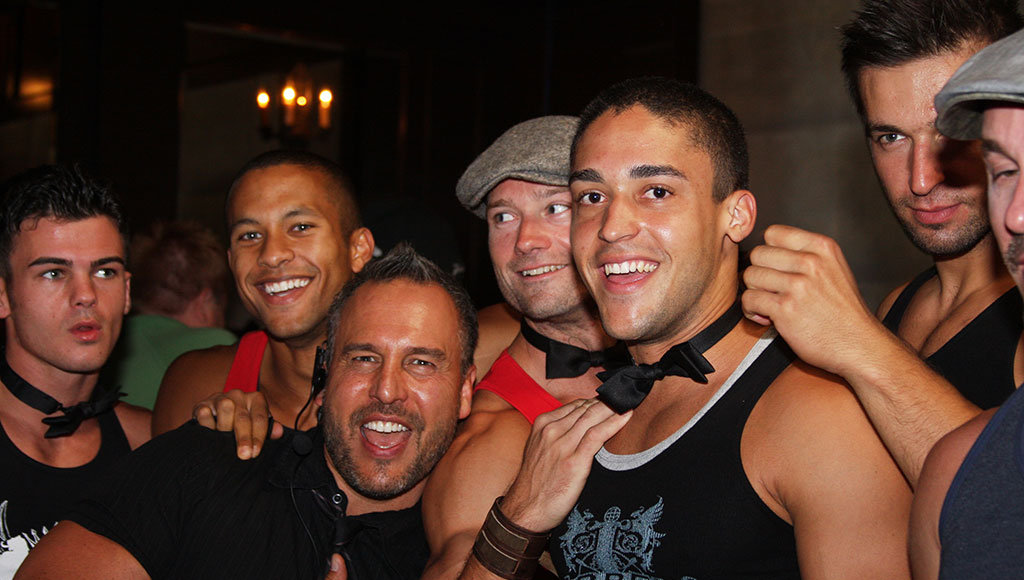
Recently on the West Coast, a certain rainbow-flagged jurisdiction considered a resolution for “Go-Go Dancer Appreciation Day” – because the mayor was fearful that the city was becoming a little too sanitized. Where else but West Hollywood, right?
Originally known as Sherman, West Hollywood has a proud history of championing renegade behaviors. The town was named for land developer Moses Sherman who housed his railroad employees in the liquor-friendly town during Prohibition. All through the Roaring Twenties, nightclubs and casinos flourished along Sunset – and rather than curb its wayward habits, the city chose not to become a part of Los Angeles, adopting the name West Hollywood instead.
To walk Santa Monica Boulevard today (once known as Route 66) is to see the imprint of West Hollywood’s raffish history. On a late summer night, we paused in front of Eleven Nightclub where nearly naked go-go boys shook their moneymakers in the huge open windows of what was once the First National Bank of Sherman. After its incarnation as a bank, the Italian Revival building became a recording studio for Cher, Patti Labelle, and Donna Summer, among others. Is it any wonder then that the 1922 structure is now an upscale gay nightclub where sin, skin, and alcohol fill the former vaults?
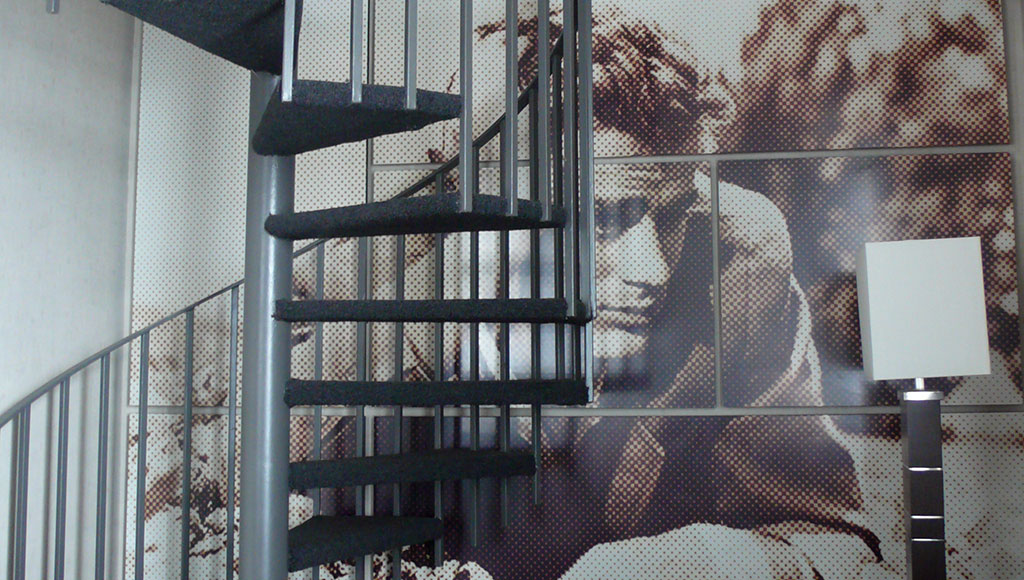
James Dean Loft Suite at the Ramada Plaza West Hollywood (Source:MRNY)
Years ago, on our way to a new life in San Francisco, we followed Route 66 across the country, right into West Hollywood. In those days, Santa Monica Boulevard was notable for Frederick’s of Hollywood – and the seemingly endless parade of working boys who cruised the boulevard of broken dreams. Sunset Strip was famous for its notorious roll-and-roll clubs like Whisky A Go-Go and the Roxy, while the Tropicana Motel on Santa Monica was where Jim Morrison lived – and Janis Joplin died.
After the fall of the Soviet Union, Russian Jews helped make West Hollywood the second-largest Russian-speaking population in the US. And it was in 1984 that a coalition of gays, seniors, and Russian immigrants fought the city of Los Angeles for the right to keep rent control – and, in the process, incorporated the city of West Hollywood. And just like that, the gayest city on the planet was miraculously born – with the zip code 90069!
West Hollywood was the first US city to create same-gender domestic partnerships – way back in 1985. Now, more than twenty-five years later, West Hollywood’s population of 35,000 is more than 40% gay, a fact that helps to explain the community’s commitment to social justice. As the first US city with a majority of gay council members, the 1.9 square-mile municipality has been at the vanguard of progressive legislation, which in West Hollywood means free HIV testing, a transgender advisory board, a prohibition on public smoking – as well as a ban on handgun sales, leaf-blowers, and the de-clawing of cats. And recently, West Hollywood became the first city in the US to ban the sale of fur apparel.
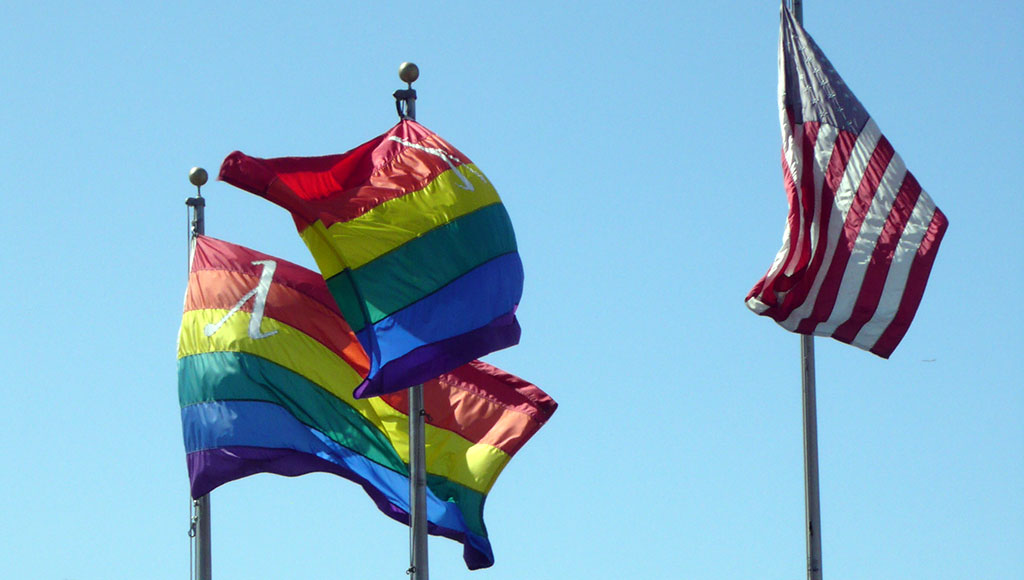
Rainbow flags along Santa Monica Boulevard (Source:MRNY)
Where you really notice the gay touch in West Hollywood is when you’re out walking. The medians along Santa Monica Boulevard, for example, are lushly landscaped and a recent public art project titled “On Route 66 Lights,” featured a display of classic California neon signs. Palm trees along the sidewalk are flanked by bronze plaques commemorating various individuals who have died of AIDS. And nearly every block along Santa Monica has at least one rainbow flag waving in the twilight breeze.
What you quickly realize about West Hollywood while walking its leafy streets lined with quaint bungalows is how much this small town reminds you of your own hometown. Or rather, the halcyon hometown you created in your mind, the one where men walked hand in hand, laughing together, white teeth gleaming, on their way to dinner at a sidewalk café.
And that’s how West Hollywood is so much more than any hometown from which you escaped (or to which you return) – because what other town of 35,000 residents has world-class art galleries, Michelin-starred restaurants, legendary nightclubs, and a smorgasbord of boutiques from the world’s most famous designers? And what other small town that you know is able to afford a brand-new $84 million library?
Each year, West Hollywood plays host to the world’s largest Halloween street festival, which is more than one mile long with over 350,000 participants. There’s also the city’s beloved Christopher Street West Pride Festival, which celebrated its 40th anniversary in 2010. And every year at Oscar time, Elton John’s much-ballyhooed and very popular fundraiser raises monies for his AIDS foundation.

Billboard along Santa Monica Boulevard (Source:MRNY)
A recent survey voted West Hollywood the “Most Walkable City” in the state of California, with WeHo scoring 89 points to San Francisco’s 85 – and one of the glories of West Hollywood is that an automobile is not mandatory for enjoying WeHo’s charms. Located at the base of the Hollywood Hills and directly adjacent to Beverly Hills, WeHo comprises three districts: Sunset Strip, Santa Monica Boulevard, and the Avenues (home to Cesar Pelli’s gargantuan Pacific Design Center). The walkable street grid makes everything in the city accessible, although there has been talk about connecting the Los Angeles metro system to West Hollywood – by means of a “Pink” subway line that would link to the Red and Purple lines. Really, could we have asked for anything more fitting?
For aficionados of gay resorts, West Hollywood has some of the same attributes of Fire Island Pines and South Beach, with some of an Atlantis Events cruise ship thrown in for good measure – and while the ocean might not be readily apparent, there’s no shortage of catwalking pretty boys.
As we wandered back from the Abbey on our last night with the gloaming settling over the boulevard, the brilliant-hued sky was a reminder that just as an oasis helps you to appreciate the unique beauty of the desert, so, too, does West Hollywood make the rest of Los Angeles look good – and the world beyond that much better.

Walkway at the Charlie, former home of Charlie Chaplin (Source:MRNY)
WHAT TO SEE:
One of West Hollywood’s more alluring attributes is its walkability. Use Santa Monica Boulevard as the backbone of the city and wander through bucolic neighborhoods such as the Norma Triangle and West Hollywood West. Amble along Alta Loma Road and see if you can feel the spiritual presence of Sal Mineo, who once lived here (before his murder on Holloway Drive). Slouch or strut along the Strip, depending on your mood – and whether you want to be mistaken for a prince of rock-and-roll or of Europe. Discover West Hollywood on foot; it’s the most walkable city in the entire state of California.
Schindler House: Los Angeles owes much to European émigrés – and particularly to those in the arts. Rudolph Schindler arrived in the States in 1914 with a fervent desire to meet and work with Frank Lloyd Wright. The young architect settled first in Chicago, overseeing Wright’s office while Wright completed work on Tokyo’s Imperial Hotel.
Located on Kings Road, Schindler House was built in 1922 and, for years, served as a salon and sanctuary for numerous artists and architects. Schindler was friends with Richard Neutra, who was still living in Vienna and to whom Schindler wrote often about the house’s construction – and it’s easy to see the influence of Schindler House on Neutra’s work throughout California.
Originally built from poured concrete, wood, and canvas, the house maintains an almost imperceptible line between indoor and outdoor spaces, in keeping with both Wright’s and Schindler’s belief in the complementary relationship between a structure and its environment.
Since 1994, Schindler House has been managed by MAK Center, one of Austria’s foremost preservationist organizations. Only a small bronze plaque at the foot of a stand of bamboo marks Schindler House apart from other addresses in the bucolic residential West Hollywood neighborhood. But to walk down the drive and through the wooden door is to slip back into a time when southern California was the land of dreams for so many people in the arts. A veritable sanctum sanctorum, Schindler House is a reminder of California’s promise.
LINK: Schindler House
Pacific Design Center: Informally known as the Blue Whale, Center Blue of the Pacific Design Center recently got a new neighbor: Cesar Pelli’s Red Building, the third and final building in the 14-acre, 1.2 million square foot complex that first opened in 1975. Center Green was completed in 1988, with Red Building opening in 2011.
Well-known as the locale for Elton John’s post-Oscar party, as well as the endpoint for the West Hollywood Pride festival, Pacific Design Center contains 130 showrooms for more than 2,000 interior product lines. The massive complex also houses Wolfgang Puck’s new restaurant, Red Seven; a fitness center; a state-of-the-art film venue; and a branch of the Museum of Contemporary Art.
At gloaming, the Center’s central fountain is a particularly peaceful place to witness a southern California sunset.
LINK: Pacific Design Center

West Hollywood’s The Gendarmerie (Source:The Gendarmerie)
WHAT TO DO:
The Gendarmerie: How often have you found yourself in a high-end spa at a five-star resort or luxury cruise – only to realize that the treatments are nowhere as exalted as the setting? What looks nice doesn’t always do the job – and while it’s always pleasant to be in tony surroundings, marble floors don’t do a thing for the pain in your back.
If you want treatments that will remind you of your own hometown masseur, the one that has worked on you for years and kept you from walking liking a hunchback, then the Gendarmerie is for you.
For the past seven years, owner Topper Schroeder has run his flagship boutique and spa like a neighborhood club. On the weekends, the West Hollywood bungalow on Nemo Street, just north of the Abbey, buzzes with energy. Local boys stop in for coffee and pastry before their treatments, while in the afternoon, Schroeder whips up another batch of lemon martinis for his clients.
For those who know fragrance, Schroeder is the man behind the cult favorite Gendarme, “the unofficial fragrance of California.” Launched in 1991, the citrus and leather fragrance is now sold in more than 1,000 stores worldwide (and recently, LL Cool J has made the juice even more popular, thanks to his declarations of Gendarme love).
With an outdoor terrace and fountains, the 1,700-square-foot boutique and spa features massage and facial rooms, as well as hair and manicure stations. What matters most at the Gendarmerie, however, is the treatments. Regarding one highly-touted masseur, Schroeder said, “He’s worth flying in for” – even 3,000 miles across the country. And once we’d been worked over, we couldn’t have agreed more. The fifty-minute treatments combine deep tissue and sports massage with Swedish massage – and the result is entirely convincing. Treatments include the aforementioned complimentary refreshments, as well as access to indoor-outdoor lounge and steam room.
As is so often the case when traveling, do what the locals do. “When in Rome” and all that. When in West Hollywood, follow the local boys to the Gendarmerie. Your body will thank you.
LINK: The Gendarmerie
WHERE TO STAY:
Ramada Plaza West Hollywood: Given the provenance of this property, it’s understandable why the Ramada Plaza has become the de facto host hotel for every major LGBT weekend in West Hollywood. After all, this is where the Tropicana Motel once stood, the famed rock-and-roll refuge with the black-tiled swimming pool. “The Trop” was where Jim Morrison lived, as well as Tom Waits, and where Andy Warhol filmed “Heat” and where Janis Joplin partied (and died), and where other residents included Blondie, Led Zeppelin, Springsteen, Sam Shepard, the Clash, the Beach Boys, Elvis Costello, and Guns and Roses. In other words, this is hallowed ground for those who like to burn the midnight oil.
Built in the late Eighties, the Ramada Plaza was completely renovated in 2008, winning both the Ramada Presidents Award, as well as the Property of the Year award for several years running. Well-managed, with an attentive and convivial staff, the hotel is perfectly located on Santa Monica, in the heart of what was once fondly referred to as “Boystown” – and location would be enough to merit a stay here, but the loft suites at Ramada Plaza are another very good reason to make a reservation.
Furnished in a sleek West Elm style, the Ramada Plaza’s duplex loft suites are large, with dark wood floors throughout and a carpeted spiral staircase leading to a capacious loft topped by a barrel ceiling. There’s no chance of hitting your head on a ceiling that is easily 30 feet high – and all that height creates a wonderful airy feeling, not unlike life in a treehouse. The large bed and piles of pillows insure that you’ll be the star of your own Hollywood dreams.
With two 42″ HDTVs, coffeemaker, refrigerator, and complimentary wireless, the loft suites are made for modern life. It’s as easy to work here as it is to entertain, thanks to sitting areas on both levels, as well as a wet bar and desk – and a photo wall mural (ours was James Dean – of course…)
You can work at the desk downstairs, take a swim in the afternoon at the hotel’s heated outdoor pool, linger on the sundeck, and then return to your suite for a movie night, upstairs in your loft screening room. From the outside balcony, you can toast to the moon – or beckon to the boys lingering along the boulevard.
During the weekend that we were in residence, a SOLD-OUT sign remained atop the reception desk each night. This was Labor Day weekend, a three-night party weekend, and the boys were everywhere. In spite of complete occupancy, the hotel remained quiet and clean throughout the weekend. After all, gay boys prefer to throw back cocktails than to throw guitars into the pool.
Apart from the pool and sundeck, on-site outlets include a Starbucks, Kitchen 24 (open all day and night), Wells Fargo, and O Burger. All this – and daily maid service. Is it any wonder Tom Waits moved in when this was “the Trop”? Buy yourself some flowers and wine at Trader Joe’s on the next block – and make this suite your new West Hollywood home.
LINK: Ramada Plaza West Hollywood
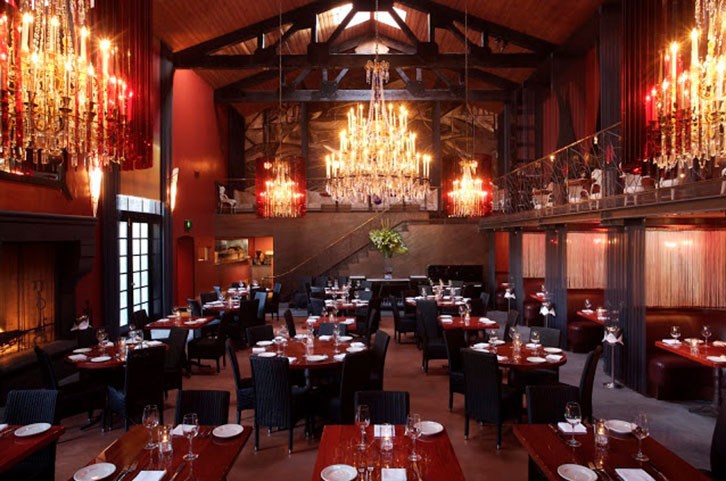
Dining Room at La Bohème, West Hollywood
WHERE TO EAT:
La Bohème: A West Hollywood institution for nearly twenty years, La Bohème is one of those iconic restaurants that help define a city. With its shimmering crystal chandeliers, glowing fireplaces, and private booths, the restaurant has been, for years, a favorite for first dates and celebrations – and yet, we all need a little freshening up and in 2007, La Bohème was completely renovated.
With a nod toward today’s more casual clientele, the resultant restaurant is both informal and professional, with a menu that features French-influenced Asian cuisine. A sesame tofu steak with garlic broccolini under a lemon soy sauce was as beautifully plated as it was delicious. And a black plum crumble with oatmeal walnut streusel topping and ginger ice cream was an ode to farm cooking at the tail end of summer. The cocktail menu is extensive (and filled with frivolous variations on classics), but this is the kind of restaurant where you’re best ordering a Martini straight up or a glass of Champagne.
Both the dining room and the patio are lovely spaces – and it’s sometimes difficult to determine where you might be happiest. Red velvet curtains and low lighting in the main room create a seductive atmosphere. Outside, a fountain gurgles as the lights of West Hollywood light up the sky. Our advice? Come back a second time. There’s always something to celebrate at La Bohème.
LINK: La Bohème
Artichoke’s Heart: First of all, most importantly: grilled artichokes. They are grilled over mesquite wood and they arrive at table smelling as succulent and delicious as they prove to be. With three halves to a plate and a dipping sauce, the artichokes are nearly a meal unto themselves – and even when finished, it’s tempting to order a second round.
The restaurant focuses on seasonal market cuisine, using a whiteboard menu wheeled to each table – and when a dish is ordered, a mark is made on the whiteboard to show how many portions remain. Most dishes are grilled over red oak wood, which creates a salivating aroma throughout the restaurant.
Service here is almost courtly – and reflective of a well-managed restaurant that believes in insuring the customer is happy and sated. Attention is paid to the details, from the warmed, moist handcloths to cleanse your hands after your artichoke indulgences right through to the ingratiating manner of the servers.
The atmosphere and furnishings evoke an upscale and modern home in Mexico City – and, indeed, the restaurant has outposts in Polanco, Guadalajara, and San Angel. At meal’s end at Artichoke’s Heart, you might find yourself considering a trip to Mexico.
LINK: Artichoke’s Heart
Tender Greens: The philosophy is local and sustainable – and the food is delicious. Served cafeteria style, the sandwiches and salads are made with produce picked daily at Scarborough Farms in Oxnard.
The walls are hung with full-size photographs of various participants from gay pride parades from the Sixties, Seventies, and Eighties. These are your brothers and sisters, the ones who helped get you where you are today – and it’s good to break bread with them.
Employees at Tender Greens are a throwback to San Francisco in the Sixties, when everything was sunshine and light – and people wore a flower in their hair. This is food that makes you feel good in a restaurant that makes you happy.
LINK: Tender Greens West Hollywood
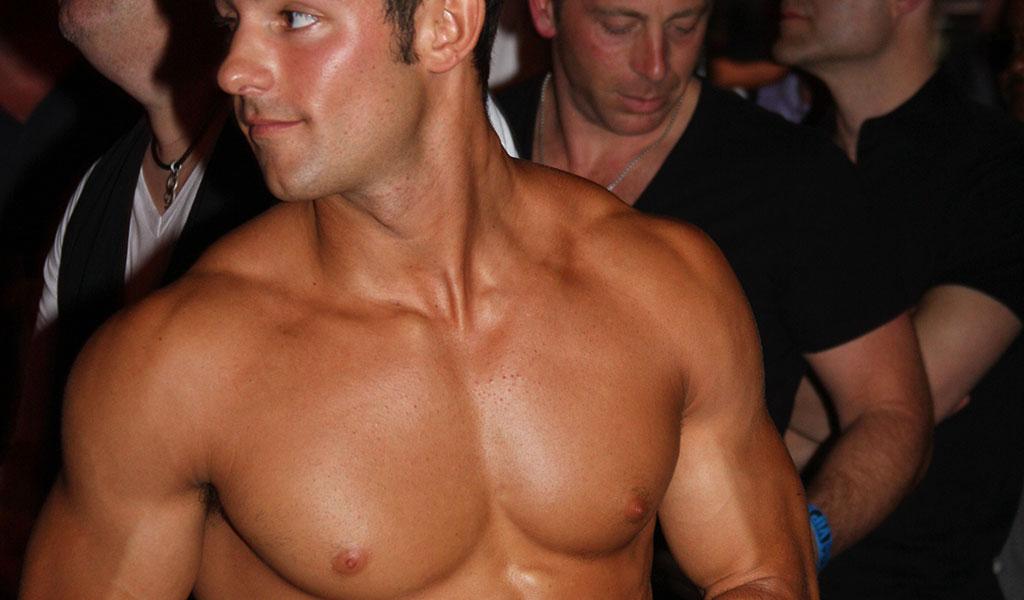
Bartender auction at the Abbey, West Hollywood (Source:MRNY)
WHERE TO PLAY:
The Abbey: It’s hard to imagine that there’s any card-carrying LGBT person who doesn’t know the Abbey. Repeatedly voted “Best Gay Bar in the World” by sources such as Logo, TripOut, and AOL, the Abbey was once a little coffee shop across the street from its current 16,000-square-feet locale on North Robertson, just south of Santa Monica. But that was more than twenty years ago and since then, the Abbey has become the favored WeHo haunt of every gay boy and girl, their numerous straight friends, as well as every Hollywood screen star and diva seeking gay love.
Christina Aguilera’s handprints and stiletto points are imbedded in concrete at the Abbey’s entrance and a beneficent portrait of Dame Elizabeth Taylor commands an entire room. In short, much like Rick’s Café in “Casablanca,” everyone comes here – and best of all, everyone has fun.
If you’re fortunate enough to run into owner David Cooley, he’ll immediately ingratiate himself into your circle and make you feel a part of his world. With the manic energy of Peewee and the bonhomie of George Clooney, Cooley is a consummate host who wants to insure that you love the Abbey as much as everyone around you.
While the Abbey has long been celebrated for its signature wedge of cake, as well as their heavy-pour cocktails, the bar/restaurant recently upgraded their menu in keeping with the bar’s recent immersion into the SBE hospitality empire – and the results are in keeping with restaurants such as Gladstones or Michael Mina’s XIV.
Nightly specials are called “Last Supper” and include eggplant Parmesan on Thursday and fish & chips on Friday. Happy hour runs from 4 -7 and the kitchen is open until two am. In fact, why not order another Lemon Drop and spend the night? That way, you’ll be there early for brunch on Saturday. Everyone else will be there, too.
LINK: The Abbey
Eleven: Located in a gorgeous Italian Revival structure that dates from 1922, Eleven Restaurant and Nightclub occupies a prime corner on Santa Monica and Larrabee, smack in the center of “Boystown.” Formerly known as the First National Bank of Sherman (West Hollywood’s original name, thanks to land developer, Moses Sherman), the building became a recording studio for artists such as Prince, Donna Summer, Patti LaBelle and Cher – so is it any wonder that it’s now one of West Hollywood’s hottest gay nightclubs?
Eleven opened in 2007 with a star-studded party, hosted by Beyonce and People Magazine – and ever since, the bar/nightclub has been a magnet for sexy boys, well-heeled diners, gourmands, and party people. With nearly naked go-go boys dancing in the archways along Santa Monica, the party spills out onto the patio for an al fresco bacchanal – day and night. Is this New Orleans – or West Hollywood? One thing’s for sure, you’ll definitely be singing “I Feel Love.”
LINK: Eleven Nightclub
Size U @ Here Lounge: Even Sunday Funday, the boys spill out onto the sidewalk connecting the Abbey to Here Lounge – and the resultant scene is a veritable block party with some of the most arrestingly attractive people in Los Angeles. Tom Whitman is the producer, but it’s the boys of WeHo and beyond who turn it out weekly for one of the city’s most fun parties. As the invite states, “Prepare to be schooled.”
LINK: Size U @ Here Lounge
The Mayan: Built in 1927 as a majestic movie palace, the Mayan reopened as a nightclub in 1990, retaining the pre-Columbian style, the hand-carved walls, and the stunning chandeliers. As a historic landmark, the Mayan is a phenomenal structure – and as a party space, it’s the center of every circuit weekend in Los Angeles. Masterbeat’s annual New York’s bacchanal happens here, as does Hard Labor, the Labor Day extravaganza that features LA’s Lord of the Drums, DJ Paulo.
LINK: The Mayan
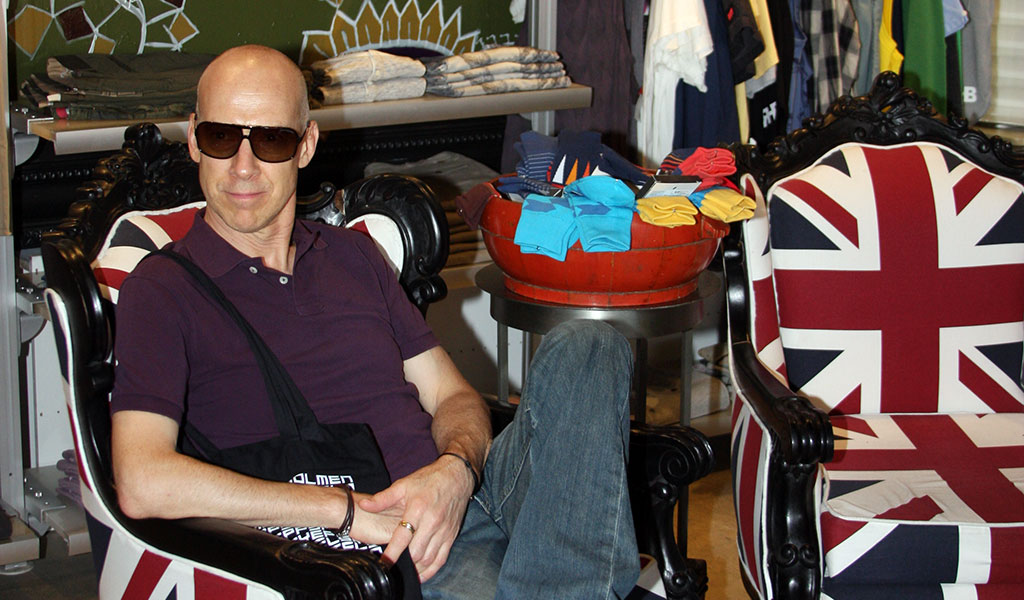
LASC, West Hollywood (Source:MRNY)
WHERE TO SHOP:
LASC: Opened in 1983 (just before the 1984 Los Angeles Olympics) as an athletic apparel store, LASC (Los Angeles Sporting Club) launched its own private label clothing line in 1987 – and since then, the store on Santa Monica Boulevard has become as iconic in the neighborhood as the Abbey. During a circuit weekend, the store is hopping with hotties – and especially when the owners host a cocktail reception to celebrate a new fashion line debuting in the boutique. Shopping at LASC is as mandatory as cruising down Santa Monica – and just as much fun.
LINK: LASC
The Beverly Center: The eight-level behemoth at the intersection of Beverly and West 3rd is a retail paradise with 160 boutiques, ranging from Bendel’s to Bloomingdales to Banana – and all of them stocked with merchandise indigenous to that casually, cool West Hollywood lifestyle. You’ll walk in a New Yorker – and exit looking like a California celebrity.
LINK: The Beverly Center
The Grove at Farmers Market: Connected to the Farmers Market (with its more than 100 produce stalls) by a vintage trolley, the Grove is an outdoor, pedestrian-only shopping center with the character of an archetypal, idyllic American village. Think “The Truman Show” or Celebration, Florida – and check your snarkiness at the door because you’ll be smitten in minutes, with your wallet wide open. With fountains and stained glass windows and more than fifty shops, the Grove recalls a time when America was the pinnacle of celebratory consumerism.
LINK: The Grove LA
Sunset Plaza: Add a bit of Capri, a dollop of St. Tropez, and a pinch of South Beach – and what you get is Sunset Plaza, the retail and restaurant mecca where European émigrés mix with well-heeled South Americans, everyone toasting to Swiss bank accounts and another season in Gstaad. Order a BolliStoli, baby; you’re on the Sunset Strip!

JetBlue Airlines (Source:MRNY)
GETTING THERE:
If you’re flying from New York, consider flying with JetBlue out of JFK. Terminal 5 (aka T5), the JetBlue terminal, is a stunningly modern terminal, with its own concert series, providing live entertainment from performers such as Taylor Swift, James Blunt, Robyn, and Raphael Saadiq. That’s right: concerts at the airport, how cool is that?
T5 is one of those terminals that actually makes you happy you’re at the airport; give yourself time to linger and decompress before your flight. There are more than forty food and retail outlets, including several restaurants with menus created by well-known chefs (such as Michael Schulson of Buddakan). Free Wi-Fi and grandstand seating make T5 as pleasurable as an afternoon at an upscale mall – and that’s saying something for a New York airport.
An architectural wonder in its own right, T5 is connected to one of modernism’s most celebrated buildings, the former TWA terminal designed by Eero Saarinen. Currently, the Saarinen building is closed to the public, but plans call for its reopening once a new tenant has been found.
As for the flight itself, JetBlue’s leather seats are clean and comfortable and the recent inauguration of the airline’s Even More Space program promises up to 38″ (as opposed to 34″) seat pitch in certain rows. The extra four inches doesn’t sound like a significant difference, but on a five-hour flight, every inch counts – and we found it worthwhile, even at $60 extra each way.
JetBlue’s staff are relaxed and cool and a pleasure to fly with; their amiable presence leavens any potential stress. As for JetBlue’s much-ballyhooed in-flight entertainment, movies are $5.99, while 36 TV channels are free – so long as the satellite system is working. Snack boxes are offered for sale, but you’re better off shopping at T5 at JFK (or Trader Joe’s in West Hollywood) before boarding your flight.
For the most part, JetBlue delivers what it promises – and gets you where you’re going with minimal wear and tear. You might even find yourself smiling in the air.
LINK: JetBlue
ADDITIONAL INFORMATION:
Click here for the MRNY gallery of West Hollywood.

























